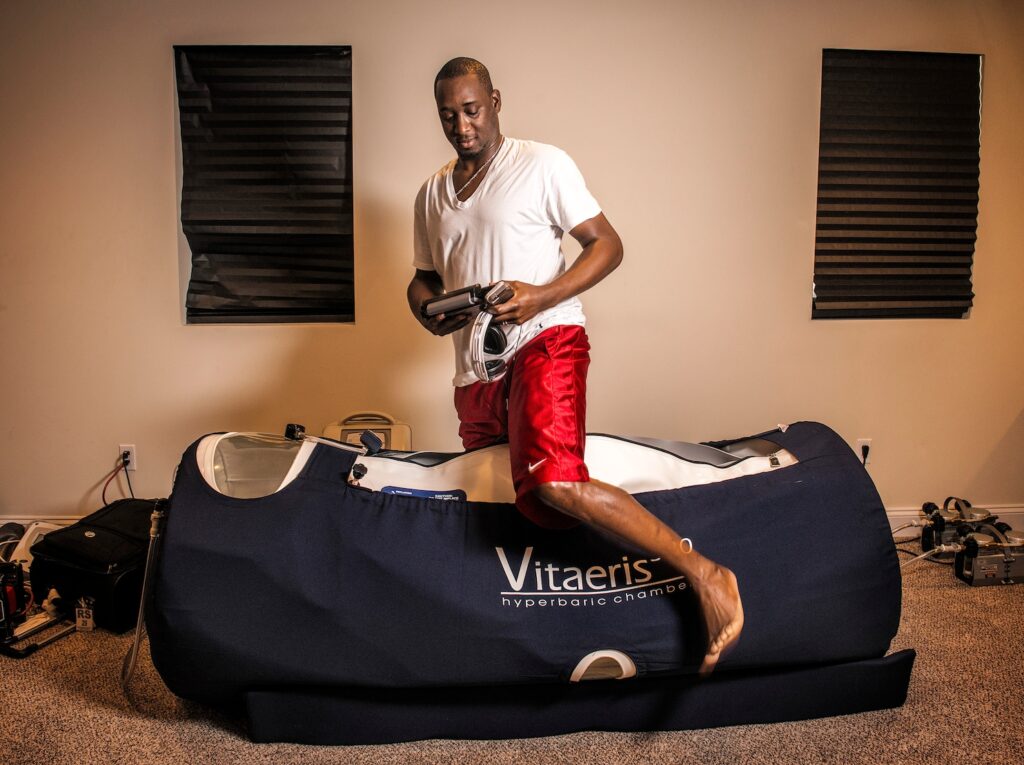Hyperbaric chambers have become increasingly popular among athletes as a way to improve their recovery and performance. These chambers are pressurized environments that contain higher levels of oxygen, which can help reduce inflammation and promote healing in the body.
Hyperbaric chambers work by increasing the amount of oxygen that is delivered to the body’s tissues and cells. This allows them to recover more quickly from intense workouts or injuries. In this article, we will explore how a hyperbaric chamber can benefit athletes and enhance their overall performance.
Understanding Hyperbaric Chambers
Hyperbaric chambers are pressurized environments that contain higher levels of oxygen than what is found in normal air. These chambers have become increasingly popular among athletes as a way to enhance their performance and speed up recovery time from injuries.
There are two main types of hyperbaric chambers: monoplace and multiplace. Monoplace chambers are designed for individual use and can accommodate only one person at a time. Multiplace chambers, on the other hand, can hold multiple people at once. They are often used in medical facilities for treating patients with severe injuries or illnesses.
Hyperbaric chambers work by increasing the amount of oxygen that is delivered to the body’s tissues and cells. This increase in oxygen helps reduce inflammation and promote healing, allowing athletes to recover more quickly from intense workouts or injuries.
During a hyperbaric therapy session, the athlete will enter the chamber wearing comfortable clothing and lie down on a padded table or chair. The chamber will then be sealed, and the pressure inside it will gradually increase to between 1.3 to 3 times atmospheric pressure. This increase in pressure allows more oxygen to dissolve into the blood plasma, which can then be easily transported throughout the body.
Once the desired pressure has been reached, pure oxygen is introduced into the chamber through a mask or hood worn by the athlete. The athlete will then breathe normally for around an hour while they relax inside the chamber.
Benefits of Using Hyperbaric Chambers for Athletes

Hyperbaric chambers have gained popularity among athletes for their numerous benefits in enhancing athletic performance and recovery. Here are some of the key benefits of using hyperbaric chambers for athletes:
Improved Blood Circulation
Hyperbaric therapy can help improve blood circulation by delivering higher levels of oxygen to the body’s tissues and cells. This increased oxygenation helps stimulate the growth of new blood vessels. In turn, this improves circulation and enhances overall athletic performance.
Reduced Inflammation and Swelling
Hyperbaric therapy has been shown to reduce inflammation and swelling in injured or stressed muscles and joints. By decreasing inflammation, athletes may experience less pain and discomfort, allowing them to recover more quickly from workouts or injuries.
Enhanced Muscle Recovery
Hyperbaric therapy can also help enhance muscle recovery by increasing the amount of oxygen delivered to muscle tissue. This increased oxygenation helps reduce muscle fatigue, soreness, and damage while promoting healing.
Boosted Immune System
Hyperbaric therapy has been shown to boost the immune system by increasing the production of white blood cells that fight off infections and diseases. This can be especially beneficial for athletes who may be more susceptible to illness due to intense training schedules.
Increased Endurance and Performance
With enhanced blood circulation, reduced inflammation, improved muscle recovery, and a boosted immune system, athletes who use hyperbaric chambers may experience increased endurance and overall athletic performance.
Precautions and Risks Involved in Using Hyperbaric Chambers
While hyperbaric chambers offer numerous benefits for athletes, it is important to understand the precautions and risks involved in using them. Here are some of the key considerations:
Safety Measures Required Before Entering the Chamber
Before entering a hyperbaric chamber, athletes must remove all metal objects from their bodies, including jewelry and piercings. They should also avoid smoking or consuming alcohol prior to the session. These substances can increase the risk of oxygen toxicity.
Possible Side Effects or Risks Involved in Using Hyperbaric Chambers
While hyperbaric therapy is generally considered safe, there are some potential side effects and risks to be aware of. These include:
- Ear pain or discomfort: The pressure changes inside the chamber can cause ear pain or discomfort similar to that experienced during air travel.
- Oxygen toxicity: If too much oxygen is delivered to the body over a prolonged period of time, it can lead to seizures, nausea, dizziness, and other symptoms.
- Fire hazard: Hyperbaric chambers use pure oxygen, which is highly flammable. Any sparks or open flames near the chamber could cause a fire.
- Claustrophobia: Some athletes may feel anxious or claustrophobic while inside the chamber due to its enclosed space.
Medical Conditions That May Make Hyperbaric Therapy Unsafe
There are certain medical conditions that may make hyperbaric therapy unsafe for athletes. These include lung disease, severe sinus congestion or ear infections, recent surgery involving an air-filled body cavity (such as abdominal surgery), and some heart conditions.
Conclusion
While hyperbaric chambers offer numerous benefits for athletes looking to enhance their performance and recovery time from injuries, it is important to take necessary precautions and understand the potential risks involved. Athletes should always consult with a healthcare professional before using a hyperbaric chamber and follow all safety guidelines carefully during each session.
Come check out Belly Up Sports on Twitter for more sports and entertainment news and content.






